What is good about the August dew pear and why it is worth growing
The summer pear variety August Dew has valuable economic and biological characteristics, thanks to which it has earned popularity among gardeners. The crop is grown mainly in the conditions of the Central Black Earth region. However, given its resistance to severe frosts, the variety is also suitable for regions with more severe climates.
In the article we will talk about the advantages and disadvantages of the variety, planting and care rules.
What type of pear is this?
August dew is a pear variety bred by breeders of VNIIGiSPR named after. I.V. Michurina by crossing the varieties Tenderness and Triumph Pakgama. From the ancestor Tenderness, the pear received high frost resistance and immunity to fungal diseases.
In 2002, the variety received permission for cultivation in the Central Black Earth region. The culture has gained popularity due to its valuable complex of economic and biological characteristics.
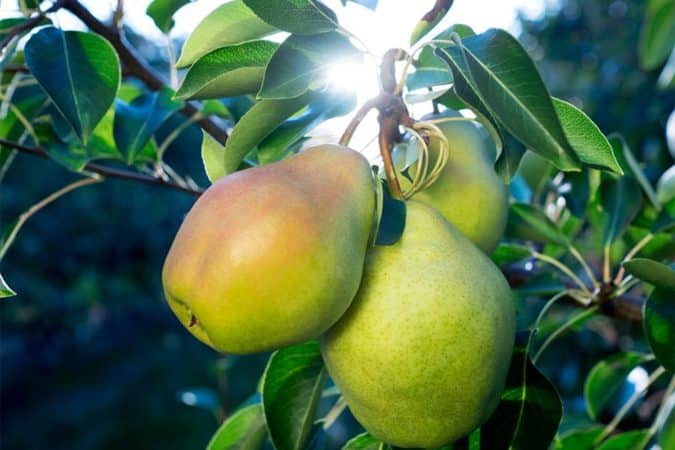
Characteristics and description of the variety
The height of the trees is 3 m. The plant has fast growth, a crown of medium density and slightly drooping branches. The rate of bud awakening and shoot formation is high. As the branches and trunk grow, they form a right angle. The bark of the trunk and skeletal branches is smooth and gray in color.
Fruit ovaries are formed on ringlets of complex and simple structure, spears. The shoots are thick, curved, geniculate, light brown in color. Lentils are small and numerous. The buds are medium in size, conical, bent.
The leaves are medium-sized, oblong-ovate, serrate-toothed along the edges, and short-pointed at the ends. The color of the leaf blade is dark green. The surface is glossy. The base is wedge-shaped. Petioles are of medium length and thickness. Internodes are medium in size. Stipules are small, saber-shaped.
The flowers are small, saucer-shaped. The petals are white, whole, unclosed. There are 7-10 flowers in one inflorescence.
The sepals are long, curved towards the peduncle. Long pistils are located above the anthers.
Important. The variety has low self-fertility and requires additional pollination. The best pollinator is the Yakovlev Memory pear.
Winter hardiness and drought resistance are high. The variety is immune to fungal and bacterial infections, scab; trees are rarely damaged by insects.
Characteristics and description of fruits
The fruits are medium-sized, weighing 100-170 g. The shape is one-dimensional, leveled, short pear-shaped, unribbed. During the period of removable maturity, the color is green. During the period of consumer ripeness, the color is green-yellow, with a faint blush. The skin is matte, smooth, with numerous brown spots. The stalks are long, thick, curved. The funnel is small, blunt-conical with slight rustiness. The calyx is closed, small. The saucer is small, wide, slightly ribbed. The heart is large, onion-shaped.
The seed chambers are closed and of medium size. The subcupal tube is short, wide, cup-shaped. The pulp is white, fine-grained, tender, juicy, melting. The taste is balanced sweet and sour. Tasting score: 4.6 on a 5-point scale.
Chemical composition of fruits:
- sugar content - 8.5%;
- acidity - 0.59%;
- pectins - 0.84%;
- P-active components - 40 mg/100 g;
- vitamin C - 13.2 mg/100 g;
- arbutin - 2.72%.
Table fruits.The harvest is harvested in mid-September. Ripe fruits stay on the branches and do not fall off. Shelf life in the refrigerator and cellar - 3 months, in a cool room - 2 weeks. Marketability 90%.
The early fruiting rate of August dew is high, fruiting is regular. The first harvest after planting is harvested after 3-4 years. The productivity of the variety is high - 10-15 kg per tree or 200 c/ha.
This is interesting:
Chemical composition of pear, calorie content and its health benefits and harms
Advantages and disadvantages of the variety
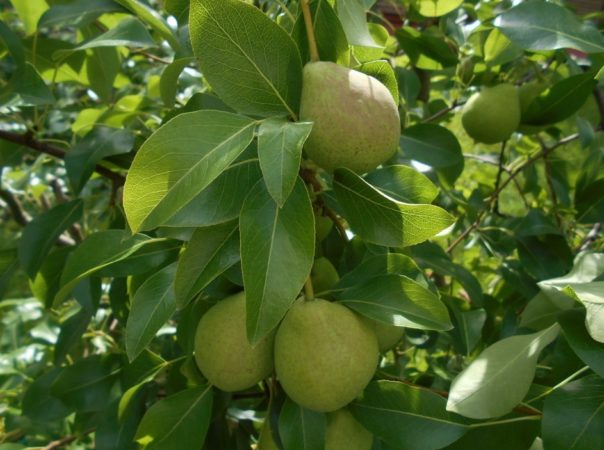
Advantages of the variety:
- ease of care;
- high productivity;
- resistance to drought and frost;
- precociousness;
- high marketability;
- excellent taste;
- attractive color and shape of the fruit;
- persistent immunity.
There are no disadvantages, except that in years of high productivity the tree produces fruits of different sizes.
Growing technology
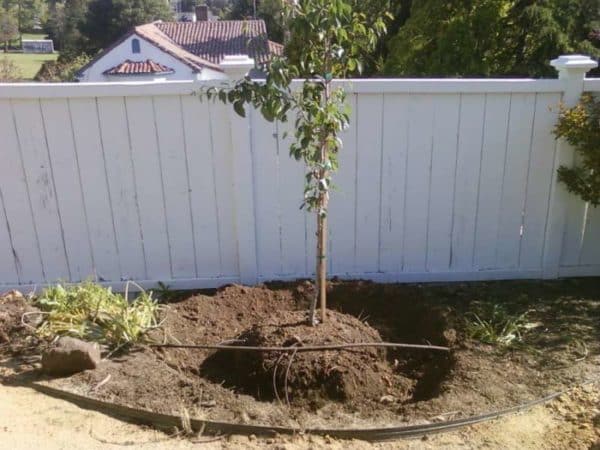
The survival rate of August dew pear seedlings is affected by the place, time of planting, as well as climatic conditions.I. The best conditions for growing the variety are the central and southern regions of central Russia.
Landing performed in early October. At this time of year, the soil is still warm and the root system takes root quickly. If planting was not possible in the fall, all work is postponed to the end of April - beginning of May.
The area for planting pear seedlings should be open and illuminated. The more sunlight a tree receives, the higher the yield, fruit quality and sugar content. It is recommended to fence the area with low fences or plant seedlings near the walls of the house to protect it from drafts. Buildings should not shade trees.
The August dew pear does not react well to stagnant water. Due to excessive soil moisture, the roots begin to rot.The best place for planting is hilly areas. If the site is located in a lowland with high groundwater levels, it is recommended to install a drainage system.
Attention. The plant grows best on loam or sandy loam-chernozem soil. On sandy soil, the pear will have to be fed with organic matter every spring. The tree is not grown in clay and peat areas.
Instructions for planting August Dew seedlings:
- The area is dug up and loosened.
- The size of the planting hole depends on the diameter of the root system. The average depth of the pit is 0.5 m, the circumference is 1 m.
- The place chosen for planting is carefully dug up and loosened.
- Lime is used to neutralize highly acidic soil. 200-350 g of ground limestone is placed at the bottom of the pit. It is also used as drainage.
- At a distance of 30 cm from the center, a tall wooden stake is installed to secure the seedling. The soil from the pit is mixed with 20-30 kg of horse humus or 80 g of ammonium nitrate and 150 g of potassium sulfate.
- The resulting soil mixture is used to fill the hole to 2/3 of its depth.
- Before planting, straighten the roots. If the rhizome is bare, up to 85% of the leaves on the seedling are torn off. Leave 2-3 leaves on each branch.
- For better adhesion to the soil, the roots are dipped in a mash of 10 liters of clay, 10 kg of humus, 300 g of superphosphate.
- The seedling is placed in the center of the hole, leaving the root collar 5-7 cm above the surface of the earth, covered with soil (clean, without impurities) and slightly compacted.
- The tree is tied to the support with a rope.
To understand the level of the planting site, a hill 40-50 cm high is formed on the site. A hole is dug inside it and the described technology is followed.
Reference. The distance between the rows should be 3-4 m due to the spreading crown of the trees.
Further care
The seedling needs regular watering for better survival. The first year after planting, the tree trunk circle is moistened 4-5 times a month from a watering can or sprinkler. Water consumption for 1 tree is 10 liters.
Adult plants are watered with a hose once every 7-8 days, 10 liters of water twice a day. In July-August, pears are watered more intensively, especially if the summer is hot and dry. During this period, flower buds form on the trees. The harvest next season depends on their quality and quantity.
Subsequently, the volume of water is adjusted taking into account weather conditions. If the summer rainfall is average, watering is stopped at the end of August to slow down the growth of shoots.
After each watering, the soil is thoroughly loosened. The tree trunk circle is cleared of weeds. To slow down the growth of weeds, the soil is mulched with sawdust or peat.
Reference. Trees planted in an area with close groundwater are watered into a ditch dug near the tree trunk.
The frequency of fertilizing depends on the composition of the soil on the site. Trees grown on sandy and poor soil are fertilized annually. On fertile soils, fertilizing is applied once every 3 years.
In the spring, the August Dew variety responds gratefully to organic matter - rotted humus or manure. Fertilizers are applied in the last days of March - early April, 1-2 kg per 1 m² of plot.
In autumn, fertilizing is applied after leaf fall. To do this, use a mixture of 20 g of ammonium nitrate, 50 g of superphosphate, 15 g of urea. Instead of superphosphate, take 600 g of wood ash. For improved soil nutrition, complex compositions with nitrogen are used.
Pruning pear trees is a mandatory procedure that helps regulate the size and sugar content of the fruit, as well as the yield of the crop.
To form the crown, the first pruning is performed after planting and 1/3 of the branches are cut off.
In spring, trees are dormant and tolerate the procedure. Every year in April, gardeners cut 1/4 of the branches. Dry and dead areas are removed first.
Autumn pruning of pears is not carried out due to the fact that the cuts will not have time to close before frost. Nevertheless, if absolutely necessary, dry and old branches are still struck, and the cuts are treated with garden varnish.
Reference. The older the tree, the less resistant it is to changing locations. 2-3 year old seedlings take root best. Pears older than 15 years are not replanted due to the risk of damaging a large number of roots.
Transfer time:
- When growing pears in mild climates, adult trees are replanted in winter at a temperature of 0°C, digging them out along with a clod of earth.
- Young trees are replanted in the fall for better adaptation to the new location. The plant will have time to put down new roots before frost, and in the spring it will grow faster. If autumn is warm and humid, transplantation is postponed to early November.
Recommendations for transplantation:
- The tree is moved together with a lump of earth to prevent injury to the roots. If the procedure is performed in dry weather, then 2-3 hours before transplanting, 30-50 liters of water are poured under the tree to fix the soil on the roots.
- Pears aged 3-5 years are dug in a circle at a distance of 70 cm from the trunk, forming a cone-shaped earthen ball 70-80 cm high. A trench 50 cm wide is dug nearby.
- The roots that extend beyond the cone are cut off with pruning shears. Those growing downwards are cut off with a shovel.
- Trees aged 6-7 years are dug at a distance of 1.4 m from the trunk and 1 m deep. The roots with the earthen lump are carefully removed and placed on polyethylene.Then the film is tied around the trunk to prevent the soil from falling off.
- In a new place, they dig a hole 40 cm deeper and wider than the coma. A layer of fertile soil mixed with humus and peat in equal proportions is poured onto the bottom.
- The tree is placed in the hole so that the root collar remains on the surface. The recess is completely filled with soil and compacted. The tree trunk circle is watered and the settled soil is mulched with sawdust.
In the spring, before the buds swell, the transplanted tree is pruned. Due to the reduction of the rhizome, there are not enough nutrients to feed the crown. Young trees are pruned to the value of 3-year growth, adults - to 5-year growth.
In the first year after transplanting, the tree is watered regularly. At the beginning of summer, pears are fed with nitroammophoska (200 g per 10 liters of water). For foliar feeding, prepare a solution of 0.3% urea. The treatment is combined with spraying with pesticides.
Possible problems, diseases, pests
To increase immunity, trees are sprayed with insecticides and fungicides in early spring. Nitrafen is highly effective. To prepare the solution, use 200-300 g of product per 10 liters of water.
Lichen and moss on trees indicate the presence of pests. To protect the plant and kill insects, use a 5% solution of iron sulfate.
The August Dew variety is resistant to scab, but in rare cases of infection it is recommended to use a 4-5% solution of urea and ammonium nitrate. For prevention, trees are sprayed with 3% Bordeaux mixture.
To protect pears from burns and insects, whitewash with slaked lime is performed in spring and summer. For 20 liters of water take 2 kg of clay and 3 kg of lime. The mixture is applied to the bark from bottom to top with a wide brush or roller.
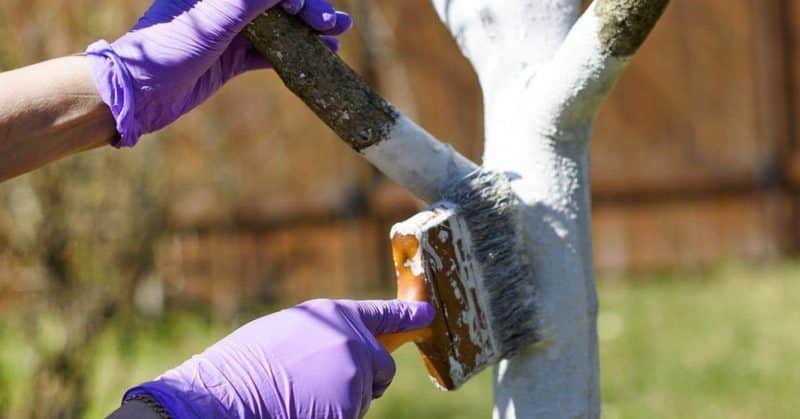
Wintering
In the fall, to protect against severe frosts, moisture-recharging irrigation is carried out; the trunk circle is mulched with horse humus in a 5 cm layer. Dry leaves and sawdust are placed on top in a 30 cm layer. The trunks of seedlings and young trees are tied with spruce branches or cardboard. The branches are secured with rope and covered with agrofibre to protect them from the wind.
Reproduction
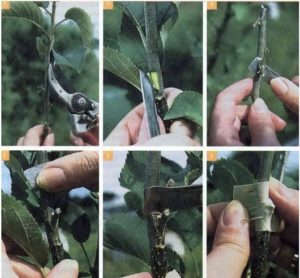
August dew propagates by grafted seedlings, cuttings, layering, seeds.
The seed method is used by breeders to obtain new varieties or rootstocks. Trees grown from cuttings begin to bear fruit earlier than grafted seedlings.
The highest quality material is grafted seedlings that meet the following standards:
- strong and developed root system 35-40 cm long;
- absence of growths at the place where the rootstock and scion are combined;
- there are 3 side branches on the trunk;
- trunk thickness - 1.5 cm.
Reviews from summer residents

Summer residents' opinions about variety August pear is mostly positive. Negative assessments are given by those who are not satisfied with the relatively low keeping quality of the fruit and the loose structure of the pulp.
Valery, Liski: “An excellent variety with strong immunity. The trees practically do not suffer from any disease, they are rarely attacked by insects, however, I carry out preventive treatments every year in early spring. The fruits are very tasty, do not need ripening, and can be eaten directly from the branch.”
Elizabeth, Kursk: “I don’t like the August dew. Firstly, I just can’t find the optimal degree of ripeness. There are green pears hanging on the tree, they smell nothing. After 3-4 days the aroma appears, I take it off, and they are already wadded. I tried to shoot them green and leave them to ripen - same story. After a couple of days, the fruits are crumbly and tasteless.”
Roman, Bryansk: “August dew bears fruit abundantly year after year and is suitable for fresh consumption. The variety is winter-hardy, tolerates drought without problems, is content with standard care, and rarely gets sick. The taste of pears is harmonious, moderately sour, moderately sweet. The pulp is juicy and melting. I pick the fruits while still green and leave them in the basement for 5-7 days, so the aroma becomes stronger.
Conclusion
The August Dew variety is highly valued by gardeners for its ease of care, high yield, strong immunity, and excellent fruit taste. Medium-sized trees occupy a small area and withstand drought and frosty winters. The variety requires additional pollination, moderate watering and fertilization with organic matter and minerals; it prefers elevated areas with fertile soil. The fruits are collected in August-September and used for fresh consumption.